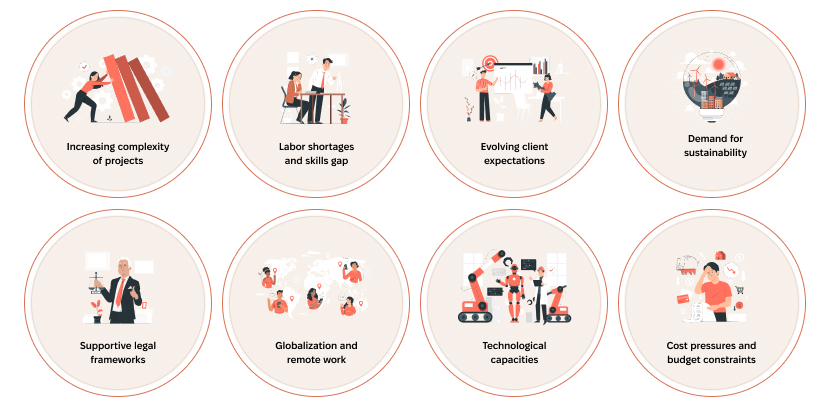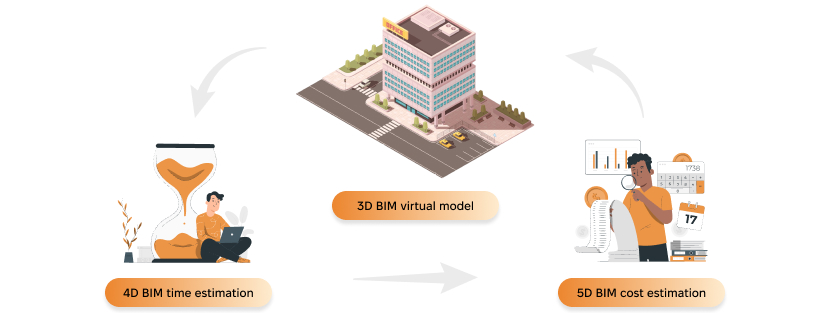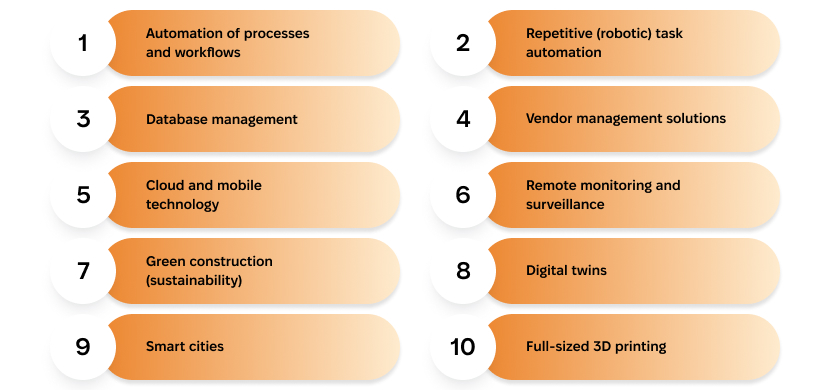How is technology changing the construction industry?
New technology in building construction revolutionizes the industry by enhancing project planning, increasing efficiency through automation, and improving stakeholder collaboration.
Published: 24 April, 2024 · 11 mins read
The construction industry is on the rise, showing a 12% gross output increase in 2024. Still, the industry faces many challenges, including talent shortages, rising project complexity, sustainability concerns, and budget constraints. For some of these issues, construction businesses turn to technologies like HD surveying, building information modeling, digital collaboration, IoT, and future-proof design. Our blog post discusses 10 tech trends in construction digitalization, from workflow automation and database management to remote monitoring and digital twins.
Slow technology adoption in construction hampers the potential to revolutionize every sector aspect, from planning to construction, fundamentally altering how we design and build. Embracing construction industry technology trends isn't merely a choice.Instead, staying competitive in an increasingly dynamic industry market is imperative.
Exoft has extensive expertise in
construction software development, aiding businesses in optimizing productivity and efficiency.
Our tailored solutions streamline on-site and back-office processes for more thoughtful decision-making and
substantial cost reductions. We craft top-tier software for construction management and business automation, including a
time-booking tool and an
emergency notifier.
This article delves into the frontier of innovation, exploring the top ten groundbreaking construction industry trends that redefine the sector. Each technology disrupts age-old norms, streamlines operations, and elevates industry standards. Unravel the significance of integrating innovative technology into construction for unparalleled efficiency and productivity gains. Let’s get started!

Construction firms turn to digital solutions to address labor shortages, meet evolving client demands, and more. Let’s explore the key factors that propel digitalization in construction, driving the sector toward unprecedented efficiency, productivity, and sustainability.
Modern construction projects often involve intricate designs, tight schedules, and complex logistics. Increasing project complexity in construction
leads to various challenges. These pitfalls include cost overruns, delays, low quality, safety issues, disputes, and poor stakeholder communication. They have profound effects on project success and outcomes.
Construction firms use digital solutions, a key driver of
technology modernization, that offer advanced project planning, coordination, and execution capabilities to mitigate those challenges effectively.
The construction
labor shortage stems from declining reliance on traditional methods and increasing entrepreneurial opportunities, which draw workers away. Additionally, negative industry perceptions, challenging work environments, and insufficient training initiatives contribute to the issue. Low women's participation, globalization, and the increasing global demand for housing due to population growth exacerbate the shortage.
Digitalization presents an opportunity to augment human labor with technology-driven solutions such as automation, robotics, and artificial intelligence. Modern technology can enhance productivity and fill critical skill gaps.
In today's commercial construction, clients demand more than just structures. They seek efficiency, transparency, and sustainability. The
requirement for improved performance mainly focuses on quality assurance, handover procedures, and building materials.
This expectation shift propels the industry towards digital point solutions that offer real-time project updates, enhanced collaboration platforms, and eco-friendly practices.
Increased environmental awareness has led to a rising demand for sustainable construction practices. The global sustainable construction market is projected to grow at a CAGR of 9.64% from 2024 to 2033, reaching $1195.28 billion by 2033. Increased infrastructural development projects, especially in developing economies, are the driving force behind this growth.

Thanks to the impact of technology and digital tools, construction firms optimize resource usage, minimize waste, and design energy-efficient structures. It aligns with evolving sustainability requirements and regulations.
Government incentives, regulations, and green building certifications are crucial in
promoting sustainable construction practices. Regulatory bodies worldwide recognize the potential of digital solutions in construction. Legislation and standards that promote technology ensure data security and encourage innovation.
This way, supporting legal frameworks creates a conducive environment for digital transformation in the construction sector.
Construction projects in an increasingly interconnected world often involve dispersed teams and stakeholders across different regions. A recent study shows how the pandemic and globalization have
prompted multinational construction companies to adapt
to remote work policies and develop new strategic plans.
Digital technologies encourage seamless communication, collaboration, and project management. Thus, construction firms can coordinate activities and overcome geographical barriers.
Tech advancements, like Building Information Modeling (BIM) drones and blockchain technology, provide construction firms with unprecedented capabilities. Furthermore, adopting the Internet of Things (IoT) and automation to improve building management
fuels construction market expansion significantly.
Technology in construction industry streamlines processes, improves accuracy, and facilitates data-driven decision-making, driving the sector toward digitalization.
Cost pressures and budget constraints also impact construction project outcomes. The
top three factors affecting cost and time control in construction projects include design and documentation issues, poor labor
productivity, and financial resource management. Digitalization offers opportunities to streamline processes, reduce overheads, and optimize resource allocation, improving project profitability.
These factors facilitate digitalization in construction, enhance competitiveness, adapt to market dynamics, and deliver projects more productively and sustainably.
Several vital influencers are shaping the technology trends in construction for 2024. They encompass various innovations, from advanced surveying techniques to collaborative digital platforms and future-proof design principles. Let’s dive into the significant construction industry technology trends driving the sector for the year ahead.
High-Definition Surveying (HDS) is the latest technology and innovation in construction industry. It
has advanced remarkably, revolutionizing the efficiency and reliability of capturing physical reality. HDS offers improved data acquisition rates, accuracy, and photorealistic representation. Integrating data from various sensors into a single model opens new data extraction and interpretation dimensions.
HDS changes surveys and monitoring of construction sites, which is highly beneficial for engineering and scientific communities. This technology provides unprecedented accuracy and detail, utilizing cutting-edge laser scanning and imaging techniques. With its help, construction teams make informed decisions and optimize project outcomes.
Building Information Modeling (BIM) keeps evolving, with the integration of time and cost dimensions (5-D BIM) increasingly prevalent. Integrating 5D BIM into construction projects positively influences time and cost performance. By incorporating project implementation time and costs into a 3D model, 5D BIM aids in better planning, coordination, and execution. As a result, it enhances efficiency and reduces expenses.

Thanks to this comprehensive approach to BIM, stakeholders visualize the physical aspects of a building, construction timelines, and associated costs. This solution facilitates planning, coordination, and project management.
Digital collaboration
revolutionizes construction project management and improves teamwork among participants. Digital solutions ensure a smooth real-time experience across design, materials management, scheduling, quality control, crew tracking, and beyond. This innovative approach transforms traditional project management models, efficiency, and cooperation.
Digital collaboration platforms reshape communication across construction teams throughout the project lifecycle. They provide centralized hubs for sharing information, documents, and real-time updates. Such platforms streamline communication, enhance transparency, and foster greater stakeholder collaboration, regardless of geographical location.
The Internet of Things (IoT) is pivotal in transforming construction sites into smart, connected environments.
Implementing IoT technologies in construction enables efficient resource utilization, process improvement, and waste reduction. It also strengthens
security measures, leading to project optimization and cost-effectiveness.
IoT sensors embedded in equipment, machinery, and structures collect vast data. Experts analyze this information to maximize resource usage, monitor site conditions, and improve safety and productivity on construction sites.
Future-proof design is a new building technology gaining traction in response to the increasing demand for sustainable and adaptable built environments. Amidst the climate change challenges, architects globally
strive to make their buildings future-proof. They have a joint commitment to leveraging precise site knowledge and maximizing existing resources.
The future-proof design emphasizes flexibility, resilience, and sustainability. It ensures that construction projects meet the evolving needs of residents, withstand environmental challenges, and minimize the need for costly retrofits or upgrades in the future. New materials, like aerogels and self-healing concrete, promise cost reduction, quicker construction, and improved quality and safety. Such principles align with future-proof design in construction.
These influential trends will drive significant advancements in construction technology in 2024, shaping project planning, execution, and management in the coming years.

Advancements in digital technology drive innovation in the construction industry. Let’s explore the cutting-edge trends reshaping construction processes and workflows in 2024, from automation and robotics to sustainable practices and smart city initiatives.
Construction automation is integral to the sector's digital transformation. It’s the technology used to
address the global housing crisis. Automation streamlines workflows, enhances productivity, optimizes project management, and ensures sustainability. It offers solutions to labor shortages and environmental concerns.
Automation has paved the way for integrating comprehensive
ERP for construction industry
. Such solutions offer seamless management of complex construction projects from start to finish. Automated design, fabrication, and construction usher in a new era of innovation. They cater to the demands of an overgrowing population while minimizing environmental impact.
This trend towards automation will keep growing as construction companies recognize the benefits of increased efficiency and productivity in their projects.
The global construction robot market will grow at a CAGR of 16.6%,
reaching a market size of $936 billion by 2033. Robotic task automation deploys robots to perform repetitive tasks traditionally carried out by human workers. In construction, it involves robotic systems for bricklaying, welding, and site scanning. They streamline processes and enhance efficiency across various project stages.
One of the compelling use cases is bricklaying robots, such as SAM (Semi-Automated Mason). It lays bricks precisely and quickly, reducing labor costs and construction time. Similarly, autonomous drones equipped with LiDAR sensors perform site surveys and inspections. They collect data on construction progress and identify potential safety hazards.
Furthermore, exoskeleton suits for workers augment their strength and endurance. They reduce the risk of injuries and improve productivity on-site.
Inaccurate, incomplete, or inconsistent data
costs the global construction industry $1.85 trillion.
Effective database management is vital when organizing and storing vast construction project data. It enhances efficiency, reduces costs, and fosters innovation in construction. Construction firms should manage data effectively. Thus, they optimize resource allocation, improve decision-making, and mitigate risks.
Data management enables smoother project execution and quicker decision-making. Ultimately. It leads to lower job costing and better project outcomes. Additionally, it supports comprehensive reporting, simplifies regulatory compliance, and enhances stakeholder collaboration. This way, effective data management drives progress and success in the construction sector.
Vendor-managed solutions
facilitate a shift from site-specific to corporate-level
logistics management. With such solutions, construction firms improve the effectiveness of small-item logistics, enhance coordination across sites, and optimize efficiency. This approach streamlines procurement. Also, it ensures on-site availability of materials and equipment and minimizes the risk of stockouts.
Vendor management solutions foster closer collaboration between suppliers and construction firms. Construction companies can focus on core activities while suppliers handle inventory replenishment and optimization. It brings cost savings, improved resource utilization, and enhanced project performance.
Cloud-based software in construction is an
enabler for innovation delivery of other emerging technologies. These include building information modeling (BIM), Internet of Things (IoT), big data analytics, virtual reality (VR), and augmented reality (AR). It provides affordable and scalable computing facilities. Also, this approach eliminates the need for costly on-site ICT infrastructure and facilitates wider adoption among SMEs in construction.
The introduction of mobile technology in the industry
facilitates collaborative communication among stakeholders on and off-site. It boosts efficiency and coordination in construction projects. With
mobile
construction app
examples like PlanGrid and Fieldwire, field workers can report progress, submit photos, and communicate issues directly from the job site. It supports greater transparency and accountability.
A comparative analysis of traditional on-site and remote monitoring systems revealed that the
latter performed better for multiple construction projects. Remote monitoring and surveillance solutions improve project performance and resource optimization. Such solutions utilize drone technology, IoT sensors, and satellite imagery. They monitor construction sites remotely and gather data on progress, safety, and environmental conditions in real time.
Drones with high-resolution cameras capture aerial footage of construction activities. This way, they provide project managers with insights into site conditions and progress. IoT sensors embedded in construction equipment and structures track equipment utilization, monitor structural integrity, and detect safety risks. In turn, satellite imagery monitors large-scale construction projects and assesses deforestation or land subsidence.
Sustainability in construction is essential due to environmental factors like energy efficiency and waste management. Moreover, it also comes with economic benefits like
improved efficiency and industry growth. Green technology in construction also addresses social issues. It reduces urban pressures and promotes long-term societal stability.
Sustainability in construction supports environmentally friendly practices and materials to lower the environmental footprint of buildings and infrastructure projects. Innovative solutions involve solar panels and wind turbines to power construction sites and buildings. It minimizes reliance on fossil fuels and mitigates greenhouse gas emissions.
Materials like bamboo, recycled steel, and engineered wood offer sustainable alternatives to promote resource conservation and circular economy principles. The examples of construction technology include sustainable practices like passive design, green roofs, and rainwater harvesting systems. They maximize energy efficiency, improve indoor air quality, and minimize water consumption. Such practices contribute to healthier and more resilient built environments.
Recent research identifies eight key areas of digital twin implementation in construction:
Digital twins create virtual models of buildings, infrastructure, and construction sites. With their help, project teams visualize, simulate, and optimize project workflows and performance. DT can simulate construction sequences, identify potential clashes or conflicts in building systems, and maximize resource utilization. Moreover, this technology enables predictive maintenance of construction assets. It reduces downtime and prolongs asset lifespan.
The Smart Cities market is set to grow significantly. It’s expected to reach $165.80 billion by 2028, growing at a CAGR of 12.15%. Smart cities leverage technology and data-driven solutions to enhance urban infrastructure, public services, and the quality of life for residents.

Smart city initiatives in construction integrate IoT sensors, communication networks, and data analytics to optimize urban development. For instance, smart traffic management systems utilize real-time data to improve traffic flow. Meanwhile, smart energy grids and buildings boost energy efficiency and sustainability through renewable sources and automation.
As construction firms embrace smart city initiatives, they can embrace technology to take project delivery and resource utilization to the next level. Also, it contributes to developing more intelligent and sustainable cities.
These days, the adoption of 3D printing in construction is limited. However, its potential as a future construction technology is substantial. The 3D printing construction market will multiply, reaching
a CAGR of 91.5% by 2028. It originates from additive manufacturing, fabricating three-dimensional objects layer by layer from digital files for efficiency and material optimization.
Full-sized 3D printing can reduce labor costs in the real world when building complex structures. Integrating this technology into construction processes fosters precision, efficiency, and cost-effectiveness. Yet, addressing the limited availability of printing materials, methods, and systems specifically tailored for construction purposes is critical.
Notably, major home building projects like the collaboration between ICON, Lennar, and BIG in Austin aim to create the world's largest 3D-printed home community. It showcases the technology's capability to solve complex futuristic construction solutions structures efficiently and accurately.
The construction industry and technology are tightly intertwined, with tech advancements driving a profound shift in the sector. From automation and robotics to sustainable practices and smart city initiatives, key trends in 2024 are reshaping how we conceive, design, and execute projects. These tendencies signal a transformative era in construction, emphasizing efficiency, sustainability, and innovation.
With Exoft's expertise, you can harness tailored
construction software development solutions
to streamline operations, enhance decision-making, and reduce costs. Our
time-tracking tool
maximized employee efficiency, increased project visibility, and improved HR management, estimation, and billing. Another case study in construction industry is the
emergency notifier
for compliance with safety regulations and improved handling of incidents and employee safety.
Embrace new types of construction technology and custom digital solutions now to be at the forefront of the industry and take innovation to the next level.
Contact us to discuss digital transformation opportunities for
your construction company.
New technology in building construction revolutionizes the industry by enhancing project planning, increasing efficiency through automation, and improving stakeholder collaboration.
Despite its benefits, technology in the construction industry has several pitfalls. It may lead to job displacement, initial implementation costs, and potential cybersecurity vulnerabilities (if not safeguarded properly).
Automation and the latest technology streamline construction processes, reduce labor requirements, improve precision, and accelerate project timelines.
Technology is reshaping the construction industry, introducing innovations like 5D BIM, drones for site monitoring, and 3D printing. It fundamentally changes how professionals design, construct, and manage buildings.
Technology has increased efficiency in construction by optimizing project planning, enabling real-time communication and collaboration, and automating repetitive tasks. It also improves data accuracy through digitalization.